
|
|
|
10.24 THE PLC ENVIRONMENT
������������10.24.1 Electrical Wiring Diagrams
������������PLC's are generally used to control the supply of power to a system. As a result, a brief examination of electrical supply wiring diagrams is worthwhile.
Generally electrical diagrams contain very basic circuit elements, such as relays, transformers, motors, fuses, lights, etc.
Within these systems there is often a mix of AC and DC power. 3 phase AC power is what is delivered universally by electric utilities, so the wiring diagrams focus on AC circuits.
A relay diagram for a simple motor with a seal in circuit might look like the one shown below,:
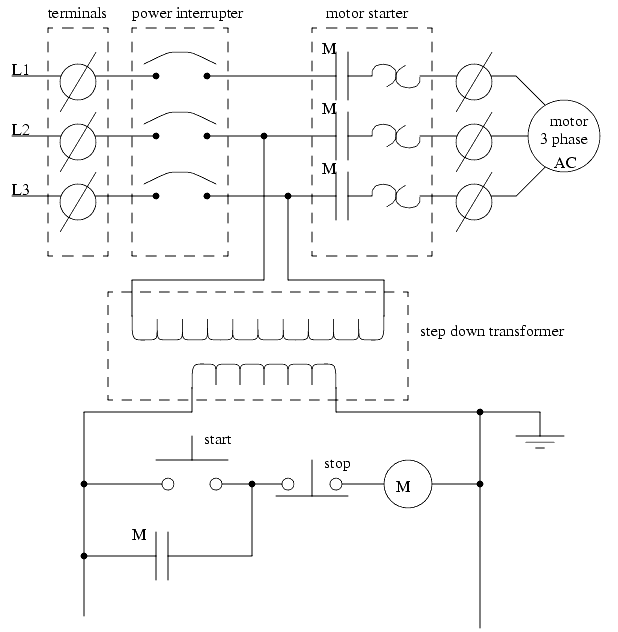
The circuit designed for the motor controller must be laid out so that it may be installed in an insulated cabinet. In the figure below, each box could be a purchased module(s).

After the Layout for the cabinet is determined, the wire paths must be determined. The figure below lays out the wire paths and modules to be used.
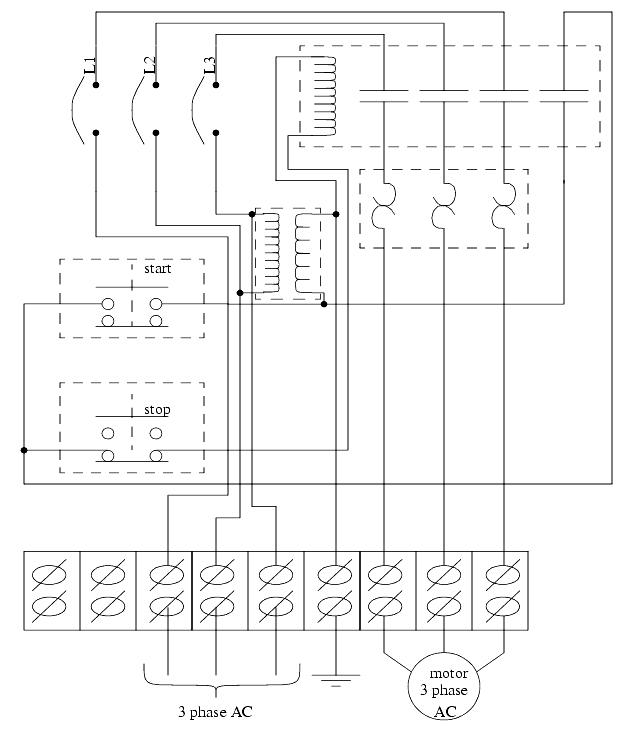
10.24.2 Wiring
������������Discrete inputs - If a group of input voltages are the same, they can be grouped together. An example of this is shown below:
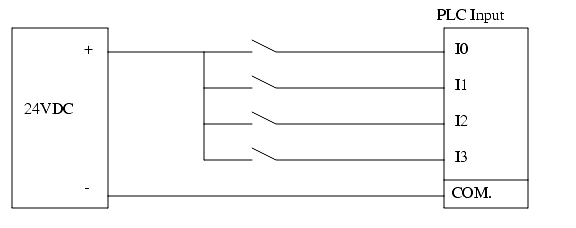
If the input voltages are different and/or come from different sources, the user might use isolated inputs.

Analog Inputs - The continuous nature of these inputs makes them very sensitive to noise. More is discussed in the next section, and an example is given below:

10.24.3 Shielding and Grounding
������������In any sort of control system, wire still carries most inputs/outputs/communications
We transmit signals along wires by pushing/pulling electrons in one end of the metal wires. Based upon the push/pull that shows up at the other end, we determine the input/output/communications. *** The key idea is that a signal propagates along the wire.
There are two problems that occur in these systems.
1. Different power sources in the same system can cause different power supply voltages at opposite ends of a wire. As a result, a current will flow and an unwanted voltage appears. This can destroy components and create false signal levels.
2. Magnetic fields crossing the long conductors or in conductor loops can induce currents, destroy equipment, give false readings, or add unwanted noise to analog data signals.
typical sources of grounding problems are:
Shielded wire is one good approach to reducing electrostatic/magnetic interference. The conductors are housed in a conducting jacket or the circuitry in housed in a conducting metal cabinet.
Resistance coupled devices can have interference through a common power source, such as power spikes or brownouts caused by other devices in a factory.
Ground loops are caused when too many separate connections to ground are made creating loops of wire that become excellent receivers for magnetic interference that induces differences in voltage between grounds on different machines. The common solution is to use a common ground bar.
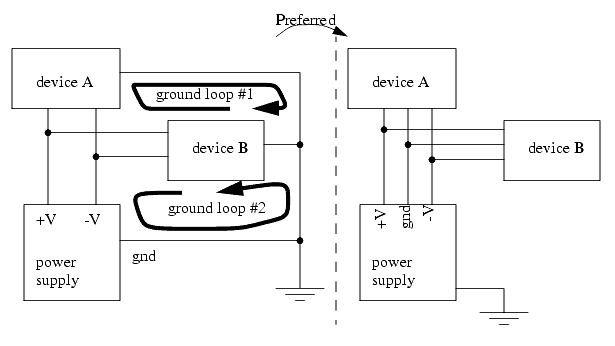
10.24.4 PLC Environment
������������Care must be taken to avoid certain environmental factors.
Dirt - dust and grime can enter the PLC through air ventilation ducts. As dirt clogs internal circuitry and external circuitry, it can effect operation. A storage cabinet such as Nema 4 or 12 can help protect the PLC.
Humidity - Humidity is not a problem with the modern plastic construction materials. But if the humidity condenses, the water can cause corrosion, conduct current, etc. Condensation should be avoided at all costs.
Temperature - The semiconductor chips in the PLC have operating ranges where they are operational. As the temperature is moved out of this range, they will not operate properly and the PLC will shut down. Ambient heat generated in the PLC will help keep the PLC operational at lower temperatures (generally to 0°C). The upper range for the devices is about 60°C, which is generally sufficient for sealed cabinets, but warm temperatures, or other heat sources (e.g. direct irradiation from the sun) can raise the temperature above acceptable limits. In extreme conditions, heating or cooling units may be required. (This includes "cold-starts" for PLCs before their semiconductors heat up).
Shock and Vibration - The nature of most industrial equipment is to apply energy to exact changes. As this energy is applied, there are shocks and vibrations induced. Both will travel through solid materials with ease. While PLCs are designed to withstand a great deal of shock and vibration, special elastomer/sprung or other mounting equipment may be required. Also note that careful consideration of vibration is also required when wiring.
- Power - Power will fluctuate in the factory as large equipment is turned on and off. To avoid this various options are available. Use an isolation transformer. A UPS (Uninterruptable Power Supply) is also becoming an inexpensive option and are widely available for personal computers.
10.24.5 SPECIAL I/O MODULES
������������High Speed Counter - When pulses are too fast to be counted during normal PLC ladder scans, a special counter can be used that will keep track of the pulses.
Position controller - A card that will drive a motor (servo motor or stepper motor), and use feedback of the motor position to increase accuracy (feedback is optional with stepper motors).
There are 2 types of PID modules. In the first, the CPU does the calculation; in the second, a second controller card does the calculation.
Thermocouple - Thermocouples can be used to measure temperature, but these low voltage devices require sensitive electronics to get accurate temperature readings.
Analog Input/Output - These cards measure voltages in various ranges and allow monitoring of continuous processes. These cards can also output analog voltages to help control external processes, etc.
Programmers - There are a few basic types of programmers in use. These tend to fall into 3 categories:
1. Hand held units (or integrated) - They allow programming of PLC using a calculator type interface. And is often done using mnemonics.
2. Specialized programming units - Effectively these are portable computers that allows graphical editing of the ladder logic, and fast uploading/downloading/monitoring of the PLC.
3. PLC Software for Personal Computers - They are similar to the specialized programming units, but the software runs on a multi-use, user supplied computer. This approach is typically preferred over 2.
Man Machine Interface (MMI) - The user can use,
PLC CPU's - A wide variety of CPU's are available and can often be used interchangeably in the rack systems. The basic formula is price/performance. The table below compares a few CPU units in various criteria.
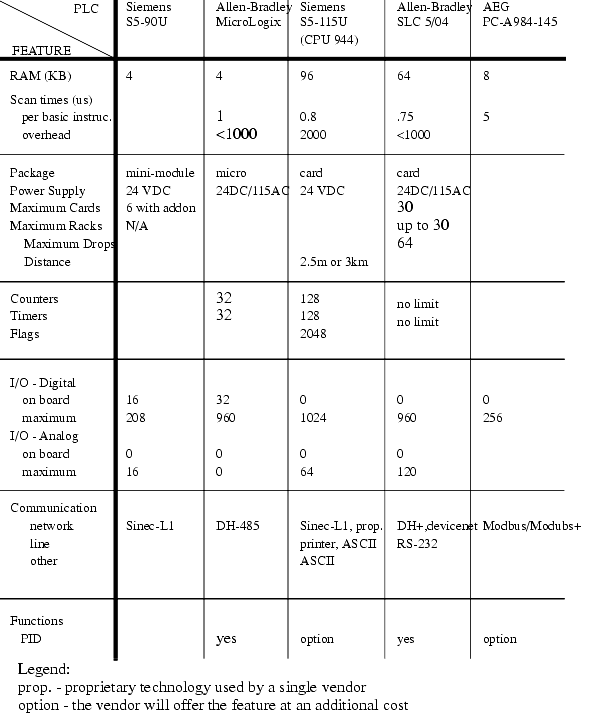
Specialty cards for IBM PC interface.
- Siemens/Allen-Bradley/Etc have cards that fit into IBM computers and will communicate with PLC's. Most modern PLCs will connect directly to a PC using ethernet or serial (RS-232) cables.
IBM PC computer cards - an IBM compatible computer card that plugs into a PLC bus and allows use of common software
ID Tags - Special "tags" can be attached to products and, as they pass within range of pickup sensors, they transmit (via radio) an ID number or a packet of data. This data can then be used, updated and rewritten to the tags by the PLC
Voice Recognition/Speech - In some cases verbal I/O can be useful. Speech recognition methods are still very limited, the user must control their speech. Background noise causes problems.
Search for More: |

Custom Search
|

|